
This is an extract from The Stack Climbing Guide to Orkney - one of eight guides to sea stack climbing around the UK available from UKClimbing as a free PDF download.
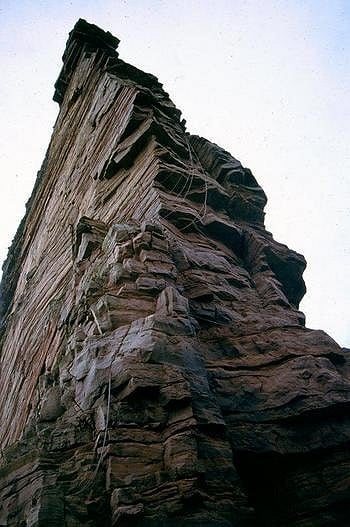
The Old Man of Hoy
This is the most famous sea stack in Britain as a result of the Bonnington, Patey and Baillie TV extravaganza. It is composed of rather decaying Orcadian sandstone standing on a granite plinth and features five climbs ranging from an acceptable El right up to E6. The stack is found just to the north of Rora Head which is east of Rackwick.
Where: MR Sheet 7 175009. It is a 1.5 mile [2.4 km] walk to the stack. Go diagonally up the hillside from the old schoolhouse. The cliffs start at Rora Head and run north to St. John's Head where it is the third highest sea cliff in the British Isles at 1,128 feet. Conachair on St. Kilda is the highest with the Kame on Foula next.
Detailed access: Descend the 400 feet to sea level down steep grassy slopes which involves a traverse over what can be steep and slippery mud. At sea level you can reach the stack without swimming by crossing the boulder bridge, presumably the remains of the arch that once connected the stack to the Hoy mainland. We'll describe the climbs going round the stack in an anti-clockwise direction starting with the east face.
Original (or East Face) Route 460 feet E1 5b
This is the original route up the east face of the stack and a memorable excursion well worth the trip. Careful attention to ropework and your descent pays dividends here.
1. 70 feet. 4b. A relatively easy pitch up sound, juggy, easy-angled rock. Ascend the shattered pillar rising from the boulder bridge up to a large ledge known as The Gallery. In the nesting season you will probably meet a fulmar here.
2. 120 feet. 5b. The big pitch. After downclimbing a short way traverse right onto the east face for 30 feet to a big corner crack. Go up this on sometimes small and indistinct holds to belay in a triangular niche on the right at the top. (Leave a rope on this pitch tied to the belays at either end. It is necessary for the abseil descent.)
3. 80 feet. 4b. Go right and then move back to the left over ledges to regain the crackline. Follow it to another large ledge.
4. 120 feet. 4b. Ascend the wall on the right then go straight up to the bottom of the final corner.
5. 70 feet. 4b. The final corner crack is like some Orcadian version of Cenotaph Corner but not nearly so tough. Climb the corner. Towards the top where the stack is split right through a seeming gale can issue from the crack in the corner. Descent: Two or three abseils down the face up which you have just climbed get you to the top of the big overhanging section - pitch 2. The next abseil involves descending below the overhangs and then swinging back in to a relatively small ledge. Use the rope left behind on that pitch (clip it into your harness) and thus pull yourself to the belay ledge. The last one down has the most fun as this guide rope has to be untied from the top belay leading to a real 'out-in-space' ab experience. Now abseil to the bottom of the stack.
First ascent: Tom Patey, Rusty Baillie, Chris Bonnington 1966.
A Few Dollars More 450 feet E3 5c
This is thought to be the best route and takes the obvious line of cracks in the north face. From the bottom of the south face cross over the west face by an obvious break to the initial buttress of the north face. A belay is gained by 30 feet of scrambling.
1. 150 feet. 4c. Go up the open groove and then follow a chimney in the right wall. At the top cross a ledge to the right and the main groove. Go up this to a ledge surmounting the initial buttress.
2. 100 feet. 5c. Step right onto the wall and climb a groove and flake to its top. Now ascend steep rock to a break in the overlap. From here climb a crackline to reach a biggish cave.
3. 100 feet. 5b. Ascend the steep crack at the left end of the cave to gain ledges near the left arete. After climbing short walls on the right you reach a grass ledge situated below the middle of the final wall.
4. 100 feet. 5b. Now go up the wall using thin cracks to arrive at a bottomless groove which is followed to a ledge on the left. Ascend a crack and a wall to the top. Descend as for East Face Route.
First ascent: Murray Hamilton, Pete Whillance, Paul Braithwaite 1984.
Ancient Mariner 550 feet E2 5b/c
The destination of the climb is the crack-cum-chimney above the half way point of the west face. To get there entails starting on the south face and crossing over. You start at a point 40 feet to the right of the arete between the west and south faces.
1. 150 feet. 5b/c. Go up a wall for 30 feet and then up a groove until you can traverse left along an obvious line about 10 feet below the top of the groove. Traverse into the centre of the wall, climb up for a few feet and continue the traverse to the arete and go up this to a ledge with a very large block. Now watch your second calculating the pendulum possibilities if he or she comes unstuck.
2. 150 feet. 5b. Onto the west face by climbing a short groove on the left and then crossing over into the target crack line across steep rock. Go up the crack to reach a belay. There are lots of ledges on the way.
3. 150 feet. 5a. Relax and romp up the crack for a rope length.
4. 100 feet. 4c. Relax some more and go up to the large grassy terrace on the right. From its top climb a wall on the left and then a corner to reach the top. Wow. An abseil descent of A Few Dollars More provides a 4 pitch descent minus the rope antics involved in descending the Original Route.
First ascent: Arnis Strapcans, ANO, 1982.
South Face 495 feet E2 5b
This climb provides some exciting positions in the middle two pitches where it passes through a series of overhangs.
1. 70 feet. 4b. Climb up to The Gallery as for the Original Route.
2. 120 feet. 5b. Now the climb changes character and forces a way up a big wall heading for the bands of overhangs above. Ascend the corner on the left, step onto the wall and go up this steeply to a flake by which you move leftwards to reach a belay ledge. The position is somewhat exciting.
3. 60 feet. 5b. To the left a crack passes through the overhangs. Climb this using the horizontal breaks to gain a recess on the left which provides a belay.
4. 150 feet. 4c. Another big pitch but at an easier standard. Climb rightwards to regain the crack and follow it once more past another set of overhangs and horizontal breaks to reach The Haven, a grassy ledge.
5. 130 feet. 4c. Embark on a rightwards traverse to gain the base of the final corner of the Original Route on the east face. You end up out of sight and sound of your second.
6. 70 feet. 4b. Climb the corner as for Original Route watching out for the gale blowing from the corner crack.
First ascent: Joe Brown, Ian McNaught-Davis, 8-9 July 1967 - 2nd BBC day.
South East Arete 520 feet A4
This route has been superseded by A Fistful Of Dollars
First ascent: Dougal Haston, Peter Crew, 8-9 July 1967 -2 nd BBC day.
A Fistful of Dollars 465 feet E5 6a
This is a direct and free version of the aided South East Arete. It is a big route in every sense and wimps need not apply. (That rules me out.) You are advised to have a rack with lots of Friends 1-3 and Rocks 1 - 9, mostly large ones and a leader, a good one.
1. 70 feet. Climb up to the gallery as for the Original Route. Above is an overhang with a flake to its left.
2. 130 feet. 6a. Climb the corner on the left for 30 feet and then step up onto the steep wall from the top of a pinnacle. Go up rightwards to the flake on the left of the overhang, climb up to the left and ascend the flake/groove to its top. It is now possible to traverse rightwards towards the arete and meet a thin crack. Ascend to a narrow and long ledge on the right.
3. 80 feet. 5c. Now go up the arete until you can step right to a crack in the overhang and then move up to a ledge on the right. Go up ledges on the right side of the arete and then climb another thin crack through another overhang and so to a squarish ledge with old peg belays.
4. 90 feet. 5c. Go up and cross over to the left side of the arete. Now climb up to a good crack on the left and up this to reach a nice ledge on the arete. From here climb a crack on the right going left to insubstantial-looking ledges on the left at its top. Ascend the wall and go over a small overhang after which you go left to the arete. Belay ledges are 20 feet further up.
5. 100 feet. 5c/6a. Another big pitch. Carry on up the arete to an overhang which you take on its left and so reach a niche. Ascend the finger crack above to gain small ledges on the headwall. Climb rightwards up and across the wall and then go up cracks to reach the arete and the top.
First ascent: Murray Hamilton, Pete Whillance, Paul Braithwaite, 1984

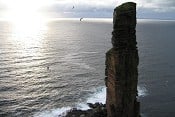
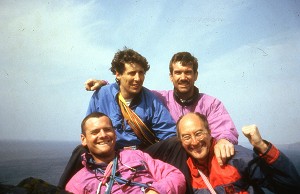
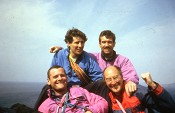
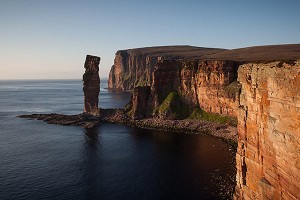
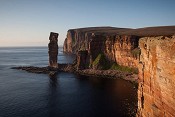



Comments